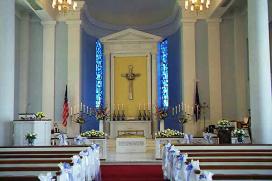History
About
The United States Merchant Marine Academy is proud to have as its House of Worship the Mariners' Memorial Chapel. Completed in 1961, the Chapel serves Midshipmen as well as civilians for various religious and social purposes. The Chapel was built to the Glory of God and to commemorate the sacrifices of the officers and men of the U. S. Merchant Marine who gave their lives at sea in World Wars I and II. The Chapel belongs to Merchant Mariners and to all Americans; it stands as one of our country’s National Memorials to America’s wartime seamen and serves to remind America of the great sacrifices of merchant mariners who go down to the sea in ships, especially in time of war.
 Within the Chapel, the Roll of Honor Book is stored. This book, permanently housed in a brass and glass display case mounted on Vermont marble immediately in front of the altar, lists the name, rank or rating, ship and date of sinking of over 7,000 officers and seamen who lost their lives on merchant ships during both World Wars. Recent research has uncovered another 600-plus names which are being recorded in a second volume. Over time this book has become one of the Merchant Marine Academy’s most cherished possessions. Daily, a selected Midshipman on duty is required to report to the chapel and ceremoniously open the case and turn a page. This ceremony is performed so that all mariners in the book will be remembered.
Within the Chapel, the Roll of Honor Book is stored. This book, permanently housed in a brass and glass display case mounted on Vermont marble immediately in front of the altar, lists the name, rank or rating, ship and date of sinking of over 7,000 officers and seamen who lost their lives on merchant ships during both World Wars. Recent research has uncovered another 600-plus names which are being recorded in a second volume. Over time this book has become one of the Merchant Marine Academy’s most cherished possessions. Daily, a selected Midshipman on duty is required to report to the chapel and ceremoniously open the case and turn a page. This ceremony is performed so that all mariners in the book will be remembered.
Main Facade
Upon looking at the front of the chapel one will see four towering pillars rising skyward to an inscription over the main entrance: “To the Glory of God and in proud and loving memory of the men of the Merchant Marine who gave their lives for their country.” In the bottom left corner is the cornerstone marked 1959 marking the beginning of the building of the chapel. On the roof of the Chapel, one notices the steeple containing a beacon. At night this flashing beacon is visible for miles. This beacon has come to symbolize the light that guides mariners lost at sea back to land or their final destination, and to remind all that they have not been forgotten. Covering the steeple is a golden dome with a weathervane in the form of a full-rigged sailing ship.
Chapel Interior
 The Chapel itself is rather simple in its design as both a memorial and an active house of worship. It is comprised of a main chapel and three smaller chapels in the basement for weekday worship. The basement of the chapel also houses a Midshipman lounge as well as the chapel offices. The interior of the main chapel is painted blue to imitate a clear sky and a calm sea. Colonial style pews and stained glass windows behind the altar also adorn the chapel. Perhaps the most impressive thing about the chapel is its towering interfaith altar. This altar, which sits on an automatic turntable, is unmistakable upon entering the chapel. Its three sides correspond to the three pre-dominant faiths in the United States, Protestant, Catholic, and Jewish. In keeping with the traditions of a maritime chapel, even the candleholders on the altar are in the form of fully rigged sailing ships.
The Chapel itself is rather simple in its design as both a memorial and an active house of worship. It is comprised of a main chapel and three smaller chapels in the basement for weekday worship. The basement of the chapel also houses a Midshipman lounge as well as the chapel offices. The interior of the main chapel is painted blue to imitate a clear sky and a calm sea. Colonial style pews and stained glass windows behind the altar also adorn the chapel. Perhaps the most impressive thing about the chapel is its towering interfaith altar. This altar, which sits on an automatic turntable, is unmistakable upon entering the chapel. Its three sides correspond to the three pre-dominant faiths in the United States, Protestant, Catholic, and Jewish. In keeping with the traditions of a maritime chapel, even the candleholders on the altar are in the form of fully rigged sailing ships.
To the left of the altar is an octagonal pulpit donated by the American Seamen’s Friend Society. To its right is a lectern given by the National Maritime Board of Great Britain. This lectern’s wood comes from the deck of the British Merchant Navy training vessel HMS Conway (1839-1955).
The Peoples' Chapel
Construction of the Chapel began in 1959 and by 1961 it was completed at a cost of $750,000. The building of the Chapel was overseen by Chaplains Danielsen, Morril, and Sullivan, and Superintendent Vice Admiral Gordon McLintock, USMS. Being completely built through public subscription without government aid has led the chapel to be thought of as belonging to the American people. The famous architectural firm of Eggers & Higgins was responsible for the building’s design; other buildings designed by this firm include as the Lincoln Memorial, the National Gallery of Art in Washington, D.C., and the Seaman’s Church Institute in New York City.
